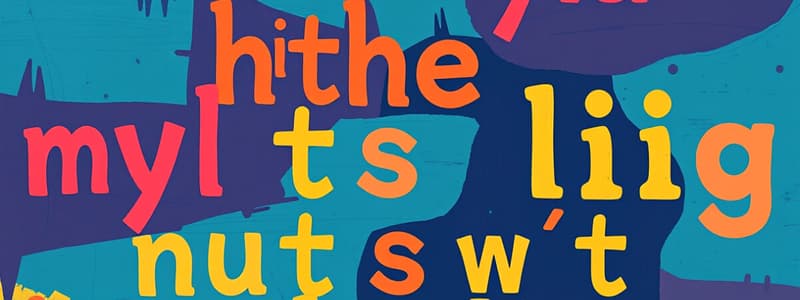Podcast
Questions and Answers
What is the primary difference between a fact and an opinion?
What is the primary difference between a fact and an opinion?
- Opinions can be proven true while facts are subjective.
- Facts are always true while opinions are always false.
- Facts can express feelings while opinions cannot.
- Facts can be proven true while opinions reflect beliefs. (correct)
Which tool is NOT typically used for comparing and contrasting elements of a story?
Which tool is NOT typically used for comparing and contrasting elements of a story?
- Venn diagram
- T-chart
- Comparison matrix
- Flowchart (correct)
What defines a cause and effect relationship?
What defines a cause and effect relationship?
- One event prevents another from happening.
- One event causes another to occur. (correct)
- One event is unrelated to another.
- One event fails to influence any outcome.
Which of the following is a characteristic of poetry?
Which of the following is a characteristic of poetry?
What is genre in literature?
What is genre in literature?
What type of work is considered nonfiction?
What type of work is considered nonfiction?
Which of the following best describes literary analysis?
Which of the following best describes literary analysis?
Which is NOT a sub-genre of fiction?
Which is NOT a sub-genre of fiction?
Which of the following is an example of literary response skills?
Which of the following is an example of literary response skills?
Which type of poetry is characterized by longer narratives recounting heroic deeds?
Which type of poetry is characterized by longer narratives recounting heroic deeds?
What should you focus on when breaking down a multisyllabic word?
What should you focus on when breaking down a multisyllabic word?
What is the last step in the five-step reading process?
What is the last step in the five-step reading process?
How can context help when reading an unfamiliar word?
How can context help when reading an unfamiliar word?
What is the main idea of a story?
What is the main idea of a story?
What is the difference between the main idea and the main topic?
What is the difference between the main idea and the main topic?
When trying to understand a multisyllabic word, what does 'decoding' refer to?
When trying to understand a multisyllabic word, what does 'decoding' refer to?
Which of the following strategies can help determine an implied main idea?
Which of the following strategies can help determine an implied main idea?
What does the five-step reading process begin with?
What does the five-step reading process begin with?
What role do affixes play in understanding a root word?
What role do affixes play in understanding a root word?
What is plagiarism in the context of writing?
What is plagiarism in the context of writing?
Which statement about the central theme of a story is accurate?
Which statement about the central theme of a story is accurate?
How can you effectively predict the content of a text?
How can you effectively predict the content of a text?
What is the purpose of using context clues while reading?
What is the purpose of using context clues while reading?
How can one effectively summarize a narrative?
How can one effectively summarize a narrative?
Which aspect is not part of the five-step reading process?
Which aspect is not part of the five-step reading process?
What does it mean to draw conclusions from a text?
What does it mean to draw conclusions from a text?
What is a key difference between comparing and contrasting information?
What is a key difference between comparing and contrasting information?
What is essential for a good paraphrase?
What is essential for a good paraphrase?
Which action can help improve comprehension when reading?
Which action can help improve comprehension when reading?
What is the primary difference between genre fiction and literary fiction?
What is the primary difference between genre fiction and literary fiction?
Which of the following is NOT a characteristic of literary fiction?
Which of the following is NOT a characteristic of literary fiction?
What defines the length categories of fiction writing?
What defines the length categories of fiction writing?
What type of nonfiction writing is characterized by literary elements?
What type of nonfiction writing is characterized by literary elements?
Which statement correctly describes an autobiography?
Which statement correctly describes an autobiography?
What is the purpose of an expository text?
What is the purpose of an expository text?
Which structure is NOT commonly associated with expository texts?
Which structure is NOT commonly associated with expository texts?
What is the typical structure of a formal essay?
What is the typical structure of a formal essay?
What role does the thesis statement play in a formal essay?
What role does the thesis statement play in a formal essay?
What is a key characteristic of a biography?
What is a key characteristic of a biography?
Flashcards are hidden until you start studying
Study Notes
Multisyllabic Words
- Multisyllabic words contain more than one vowel sound or syllable.
- Apply basic spelling patterns to break down and decode these words for proper pronunciation.
- Focus on identifying vowels, consonants, and affixes (prefixes and suffixes) associated with root words.
Reading with Purpose
- A structured five-step reading process enhances understanding: prepare your environment, preview text, predict content, paraphrase, and visualize in your own words.
- This process ensures you are reading with intention and improving comprehension.
Context Clues
- Context clues in surrounding text can help decipher unfamiliar words and deduce their meanings.
- Even unknown words can be interpreted correctly by analyzing their context in the sentence.
Main Idea of a Story
- The main idea conveys the central concept the author wants to communicate; it can be explicit or implied.
- Strategies for identifying the implied main idea include examining the main problem, narrative patterns, character insights, summarizing the story, and revisiting the introduction and conclusion.
- Differentiate between main idea, topic (subject), and central theme (underlying message).
Summary Writing
- A summary condenses larger pieces of content, addressing core elements such as who, what, when, where, why, and how.
- Include a topic sentence that encapsulates the main concept and relevant details while omitting insignificant information.
Paraphrasing
- Paraphrasing involves rewording information in your own terms while maintaining the original meaning, crucial for avoiding plagiarism.
- Important to keep specific facts (names, dates) unchanged while altering the wording for descriptions and explanations.
- Effective paraphrasing enhances note-taking efficiency and comprehension.
Making Inferences
- Inferences allow readers to deduce information not explicitly stated in the text or visual material.
- Use reasoning and existing knowledge to make educated guesses about underlying meanings or missing elements.
Drawing Conclusions
- Drawing conclusions requires connecting text details, prior knowledge, and personal experiences to understand characters and plot developments.
Comparing and Contrasting Information
- Comparing identifies similarities, while contrasting highlights differences between elements.
- Utilize keywords and ask questions to facilitate comparisons across texts, supporting accurate analysis.
Cause and Effect
- Recognize cause-and-effect relationships where one event influences another.
- Signal words help in identifying these relationships within texts.
Literary Response and Analysis
- Literary response skills help engage with literature, while literary analysis examines how narrative components contribute to overall meaning.
- Asking questions, analyzing story grammar, and acknowledging cultural perspectives enrich analysis.
Facts vs. Opinions
- Facts are provable truths; opinions are personal beliefs or feelings.
- Key questions: Can the statement be proven true? Is it based on personal beliefs?
Genre in Literature
- Genres categorize artistic works by specific characteristics.
- Four main genres: poetry, fiction, nonfiction, drama, each using figurative language.
- Poetry includes lyric (emotion-focused) and narrative (storytelling) subgenres; epic poetry recounts heroic tales.
Fiction vs. Nonfiction
- Fiction: imaginative stories with invented characters and plots, includes subcategories like genre and literary fiction.
- Nonfiction: factual writing conveying real-life events, divided into informational and literary, such as biographies and autobiographies.
Expository Texts
- Expository texts inform or educate about a specific topic, presenting factual information clearly and concisely.
- Structures of expository texts include cause and effect, compare/contrast, descriptive, problem-solution, and sequence formats.
Essay Writing
- Formal essays are structured and objective, generally comprising five paragraphs: one introduction, three body paragraphs, and one conclusion.
- Key essay types include expository, compare and contrast, cause and effect, and argumentative essays, each serving different rhetorical purposes.
Studying That Suits You
Use AI to generate personalized quizzes and flashcards to suit your learning preferences.




